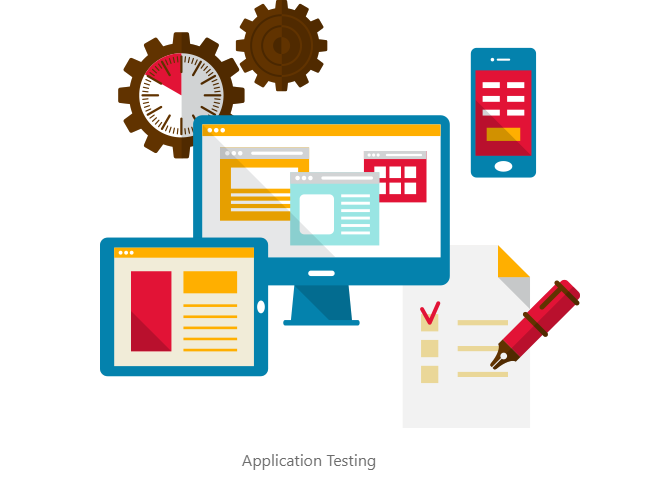
Application testing plays a critical role in today’s technology-driven world, where the success of an application directly impacts customer satisfaction and business reputation. Whether it’s a mobile app, web application, or desktop software, thorough testing is essential to ensure a seamless user experience and overall quality assurance. In this blog, we will explore the importance of application testing, its different types, and why it should be an integral part of your development process.
Why is Application Testing Important?
Enhancing User Experience: Application testing helps to identify and fix any usability issues, ensuring the end-users have a smooth and intuitive experience. By testing the application on various devices, operating systems, and browsers, you can ensure compatibility and consistent performance across all platforms.
Identifying Bugs and Issues: Applications often encounter bugs and glitches that can hinder functionality and disrupt the user experience. Thorough testing helps identify and fix these issues before the application is released to the market, saving time, effort, and potential damage to your brand reputation.
Optimizing Performance: Testing the application’s performance under different scenarios helps to optimize its speed, responsiveness, and stability. Load testing, stress testing, and performance testing are crucial to ensure applications can handle high traffic and heavy workloads without crashing or slowing down.
Security and Data Protection: Application testing also focuses on identifying and rectifying vulnerabilities, ensuring that sensitive user information is secure against potential cyber threats. Penetration testing and security audits help in fortifying the application’s security measures and safeguarding user data.
Types of Application Testing
Functional Testing: This testing ensures that the application’s features and functionalities work as intended. Test cases are designed to validate individual functions, user interactions, and overall system behavior.
Usability Testing: Usability testing focuses on evaluating the application’s ease of use and user-friendliness. It involves collecting feedback from real users to identify usability issues and make improvements accordingly.
Compatibility Testing: Compatibility testing ensures application performs well across different devices, browsers, and operating systems. It helps in identifying and fixing any compatibility-related issues that may arise.
Performance Testing: Performance testing assesses the application’s responsiveness, scalability, and stability under various load conditions. This type of testing is crucial to ensure the application can handle user traffic and perform optimally.
Security Testing: Security testing involves evaluating the application’s vulnerability to potential security threats. It helps to identify and address any weaknesses or loopholes in the application’s security measures.
Application Testing Tools and Methodologies
Application testing tools and methodologies are used to ensure the quality, reliability, and functionality of software applications.
Here are some commonly used tools and methodologies in application testing:
Test Management Tools: These tools help in managing test cases, test plans, and test execution. Examples include TestRail, Zephyr, and Microsoft Test Manager.
Test Automation Tools: These tools automate the execution of test cases, reducing manual effort and increasing test coverage. Popular test automation tools include Selenium, Appium, and HP UFT (Unified Functional Testing).
Performance Testing Tools: These tools are used to evaluate the performance, scalability, and responsiveness of applications under different load conditions. Tools like Apache JMeter, LoadRunner, and Gatling are used for performance testing.
Security Testing Tools: These tools identify vulnerabilities and security weaknesses in applications. Popular security testing tools include OWASP ZAP, Burp Suite, and Nessus.
Code Review Tools: These tools analyze the source code to identify coding errors, security vulnerabilities, and adherence to coding standards. Examples include SonarQube, Checkmarx, and Veracode.
Continuous Integration/Continuous Deployment (CI/CD) Tools: These tools automate the build, testing, and deployment processes to ensure a streamlined and efficient software delivery pipeline. Popular CI/CD tools include Jenkins, GitLab CI/CD, and CircleCI.
Agile Testing Methodology: Agile testing methodologies, such as Scrum or Kanban, focus on iterative and incremental development, with testing integrated throughout the development lifecycle. It emphasizes collaboration, frequent feedback, and continuous testing.
Waterfall Testing Methodology: The waterfall methodology follows a sequential approach, where testing is performed after development. It includes requirements gathering, design, development, testing, and deployment.
Exploratory Testing: This methodology involves simultaneous learning, test design, and test execution, without predefined test scripts. It relies on tester expertise and encourages creativity and flexibility in uncovering defects.
Test Driven Development (TDD): TDD is a development methodology where tests are written before writing the actual code. It helps ensure code meets the desired requirements and facilitates ongoing testing.
These tools and methodologies are important in achieving efficient and effective application testing, ensuring that software applications meet user expectations and perform reliably in various scenarios.
Conclusion
Application testing is not just an add-on but an integral part of the development process for any digital product. By conducting thorough testing, you can identify and rectify issues, optimize performance, enhance user experience, and ensure the security and integrity of your application. Investing in application testing upfront can save you time, money, and potential setbacks down the line. So, integrate application testing into your development workflow and deliver a flawless product that meets user expectations and drives business success
I am only writing to make you know of the remarkable experience my princess gained reading through your web site. She learned some issues, most notably what it is like to have an awesome helping style to make others with ease comprehend several problematic topics. You truly did more than her expected results. Thanks for supplying these necessary, dependable, educational and even easy thoughts on your topic to Kate.